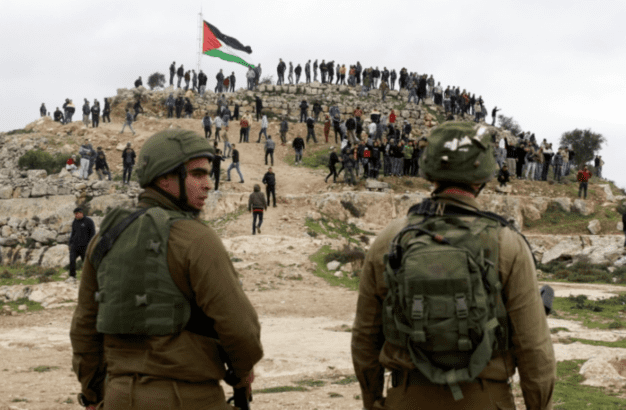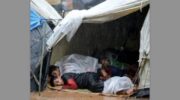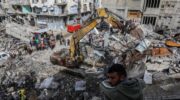Every day is an unofficial Land Day because every day there is dispossession to protest. (Pictured: Israeli soldiers stand guard as Palestinian demonstrators gather during a protest against Israeli settlements in Beita town near Nablus, March 2, 2020)
March 30th is Land Day, an annual commemoration of those killed protesting Israeli theft of Palestinian lands 46 years ago. But even now, there is a Nakba everywhere you look.
by Mohammed El-Kurd, reposted from The Nation, March 30, 2022
Today is Land Day in Palestine—a day that commemorates the moment 46 years ago when Israeli forces shot and killed six Palestinians with Israeli citizenship who dared to protest the Israeli regime’s confiscation of tens of thousands of dunams of Palestinian land.
The murders took place during a moment of uprising—much like now—on the eve of a general strike that had been called by the Initiative for the Defense of Lands, a committee established in 1975 by Palestinian political activists, public intellectuals, lawyers, doctors, and journalists.
The night before, Palestinians in various towns within the 1948 territories burned tires and closed streets to block the forces sent by Golda Meir and Yitzhak Rabin. At dawn, the army raided numerous Palestinian villages with military vehicles and tanks, wounding about 50 Palestinians, arresting 300, and killing six—Raja Abu Raya, Khader Khalaileh, Khadija Shawahna, Khair Yassin, Raafat Zuhairi, Mohsen Taha.
Despite the violent crackdown—or perhaps because of it—the strike was carried out successfully, and the repression meant to deter nationalist sentiment ignited an anti-colonial mood so magnetic it connected the fragmented realities of Palestinians in 1948 territories, Jerusalem, Gaza, the West Bank, and the diaspora like never before.
Forty-six years later, people throughout the world continue to memorialize this moment, honoring the martyrdom of those who fell by protesting, planting olive trees, and reminding one another that Land Day is not mere folklore. It is not a commemoration of a tragedy that once was. It is a commemoration of something ongoing and present tense.
Since that bloody day in 1976, countless new settlements have overwhelmed stolen Palestinian land. Our towns and neighborhoods continue to be encircled by colonies and military outposts, their residents isolated from one another. The Israeli government has killed and displaced thousands of Palestinians—both those who defended their lands and those who walked in the shadows, heads bowed, thinking they could evade the horrors of the Occupation.

Everywhere you look on the map, there is a story of dispossession. In the Naqab, Palestinian Bedouins are uprooted and replaced by pine trees. In Silwan, the Occupation forces demolish homes to fulfill a biblical fantasy. In Sheikh Jarrah, ethnic cleansing comes disguised as a “real-estate dispute.” In Beita, settlers build illegal outposts on hilltops, and soldiers kill for them. Out of all the loot, the Land remains—indisputably—the most valuable.
As I observe this Land Day, I can tell a dozen stories of dispossession, but today I want to write about the communities of Masafer Yatta, whose villages, tucked in the South Hebron Hills, are under imminent threat of expulsion.
On March 15, the people of Masafer Yatta were granted travel permits by the Israeli Occupation authorities to enter occupied Jerusalem for a hearing at the Supreme Court. Photographs of them sitting in the courtroom reminded me of my own time there.
I remembered my family and neighbors trying to trace meaning in the Hebrew deliberations, some of them fluent in the language and some who didn’t speak it at all. We whispered in each other’s ears fragments of what the judges and lawyers said, as if playing a miserable game of broken telephone.
The hearing on March 15 marked the beginning of the end to an excruciating 20-year legal battle to save eight Palestinian villages in the South Hebron Hills. Sometime in June, an Israeli judge—himself a settler in the occupied West Bank—will rule whether to expel some 1300 Palestinians from their ancestral lands, which they have inhabited and cultivated for generations.
When reading about Masafer Yatta, you will likely encounter a type of reporting that would have you believe that Palestinians are to blame for their own dispossession. A headline from The Times of Israel reads, “High court to rule on expelling over 1000 Palestinians from West Bank firing zone,” as if the people in Masafer Yatta had gleefully decided to build their homes in the middle of a shooting range, choosing for their children to play amid the raining bullets or for their livestock to graze between tank tracks. Yes, who among us could resist the allure?
The reality, of course, is quite different. In the early 1980s, the Israeli army designated Masafer Yatta—22 villages on 30,000 dunams of Palestinian land—as “Firing Zone 918,” declaring it off-limits to anyone but the Israeli military and those it permits to remain there (this does not apply to Jewish citizens of the state or Jews from around the world).

Then, in 1999, the Occupation authorities committed the war crime of expelling the residents of 14 of those villages from the lands they had inhabited for generations, on the grounds that they had been “illegally living in a firing zone.” That wasn’t the only incident of forced displacement. According to B’Tselem, “since 2006, Israeli authorities have demolished 64 homes in these communities, in which 346 people, including 155 minors, lived.”
A recently uncovered 40-year-old official document found in the Israel State Archive confirmed that the regime declared military zones in that area solely to expel the native residents.
This discovery raised no eyebrows among Palestinians, however, who arrived at this conclusion decades ago. Declaring Palestinian lands to be putative military zones is one of the many methods of land-grabbing at the regime’s disposal, and it happens more often than one would think. Today, 18 percent of the lands in the occupied West Bank are considered “firing zones.”
The Palestinians in the Hills—who not only predate said “military zones” but the Zionist state itself—are fighting for the remaining eight villages, often in the face of extreme harassment and danger. “Residents of Masafer Yatta are the target of constant raids, arrests, settler violence, land seizures, and home demolitions.
It is understood among the people of the area that these obstacles are thrown in their way to terrorize them into leaving,” my friend and filmmaker Ryah Aqel explained in an article we wrote together for The Nation in early 2021.

We wrote the article after Aqel’s cousin, Harun Abu Aram, had been shot and paralyzed by the Israeli military. It is the tortuous reality of life in a targeted Palestinian village, however, that families like Aqel’s rarely experience just one unjust loss. In 2000, Abu Aram’s uncle, Khalil Mohammad, then just 14 years old, was killed by an unexploded bomb left behind by the Israeli occupation forces on the family’s own grazing land.
Twenty-two years later, the possibility of falling victim to leftover Israeli explosives remains an enduring threat. “Israeli occupation forces now conduct military training dangerously close to the villagers’ homes. It is disturbingly common to find remnants of US-made ammunition, be it bullets or tank shells, in the hills. In fact, schools in the South Hebron Hills are required to teach children how to distinguish between leftover weapons and debris,” Aqel explained.
And there are other consequences, other horrors. Children and their grandparents sit and watch military tanks parade at their front doors while almost all have stories of loved ones who have been injured or killed by the army or their leftover explosives. I
think about Hajj Suleiman Eid al-Hathaleen, an elder of Masafer Yatta, who was intentionally run over and killed by an Israeli tow truck just two months ago. His towering presence once gave strength to the anti-occupation movement. Today his loved ones mourn him while the world barely notices.
To know that these atrocities are the result of military men and politicians simply placing their index fingers on a Palestinian area and dismembering it for the sake of political dominance and settler expansion is to live in a state of constant bewilderment and outrage. It is one that I and so many other Palestinians know well.
Approximately 30 kilometers from the Hebron Hills, my neighborhood, Sheikh Jarrah, fights its own battle against colonialism. Perhaps because I was born into it, I didn’t think our reality was bizarre until I stepped out of it.
But bizarre it is: Someone from Long Island decided one day to move to Jerusalem, thousands of miles from his home, and claim my home as if by divine decree and with the support of billionaire-backed settler organizations. The eviction orders and court summons visited upon us by employees of said settler organizations are so common as to be almost mundane—as are the friendships between those employees and the city council members.
Even now, Israeli parliamentarians set up make-shift tents in my neighbors’ front yards, performing their spectacles in time for election season.

The Israeli regime’s architecture of displacement uses many different methods but all have a single goal: to control as much land as possible while keeping as few Palestinians possible without triggering international alarm bells—be it through manufacturing “real-estate disputes”; demolishing homes built “without authorization”; stealing lands by declaring them to be “military zones,” “archealogic sites,” “environmentally protected,” or “state-owned”; or simply by stunting the growth of Palestinian communities by isolating them and severing their social and economic ties with neighboring towns.
The Zionist project has always created narratives to legalize and justify replacing the native with the settler.
The land grabs in Masafer Yatta highlight the importance of Land Day as an event that unites and mobilizes Palestinians everywhere against ongoing colonial expansion. In fact, what sparked Land Day’s inaugural general strike is similar to what is happening in the South Hebron Hills and what led to the recent resurgence of resistance in the Naqab.
In early February 1976, a year after expropriating 3,000 dunams of Palestinian land in Kafr Qassem (where the Israeli army carried out a horrific massacre in 1956, killing 49 Palestinians), the Israeli military designated the farmlands of three villages “military training zones.” Those village were Arraba, Sakhnin, and Deir Hanna in the Northern District of the country.
Much like those living in Masafer Yatta, the residents of these villages were told that entering their farmlands would be considered a criminal offense for which they would be punished. Shortly after, on February 29, the Israeli regime—led by the West’s beloved “Soldier of Peace” and the mastermind behind the “Break the Bones” policy, Yitzhak Rabin—confiscated 20,000 dunams of Palestinian lands in the Galilee, declaring them “state-owned.”
Those practices lit a fire under the seats of Palestinians everywhere. Palestinians protested in solidarity and struck in parallel with their compatriots in 1948-territories. Every year since, Land Day has served to remind the world of the connection Palestinians have with the land and their relentless commitment to defending it.

It is not lost on Palestinians how the regime continues to use discriminatory laws and fictitious narratives to justify ethnic cleansing. Some Palestinians have even satirized the absurdity of settler-colonial rule. “God has become a refugee, sir/ Confiscate therefore even the carpet of the mosque,” the great poet Rashid Hussein wrote in his 1960 poem “God Is a Refugee,” penned in protest of the 1960 “Land Law,” which classified 93 percent of the lands in historic Palestine as “state-owned,” and the 1950 “Absentee Property Law,” which allowed the state to seize the properties of Palestinian refugees dispossessed during the Nakba. “You have liberated even the grazing cattle, the day you gave Abraham Mohammed’s field.”
Should the settler judge rule in favor of the expulsion of the communities in Masafer Yatta, the 1,300 Palestinians living there will not only be made homeless but will also be ripped from the lands they have loved and nurtured for generations. The Israeli buildings will grow taller, and the settler population will grow faster. Their hands, as Hussein wrote in his poem, will “sow land mines in [our] gardens.” And as their colonies cut off the circulation between our towns, they will tell us, “You are nothing but the scraps of nations, living scattered among caves!”
But Hussein’s poem offers other insights, other reminders—words that echo with particular resonance this Land Day. “But [they] have forgotten,” he observes, “that untended coals are enough to start a fire… Enough to light a path.”
Mohammed El-Kurd is the Palestine correspondent for The Nation. He writes primarily about dispossession in Jerusalem and colonization in Palestine. His debut book is a volume of poetry, Rifqa (Haymarket Books).
RELATED READING:
- Thanks to the US, the Israeli Military Shot My Cousin, Harun Abu Aram
- When your village becomes a “firing zone” – that’s ethnic cleansing
- Gideon Levy: a Quiet, Cruel Population Transfer in South Hebron Hills
- Sheikh Jarrah: How the US media is erasing Israel’s crimes
- 1951 Documents Reveal Israel’s Intent to Ethnically Cleanse Bedouin from their Lands
- When Israel demolishes Palestinians’ homes, they live in caves
VIDEOS:





